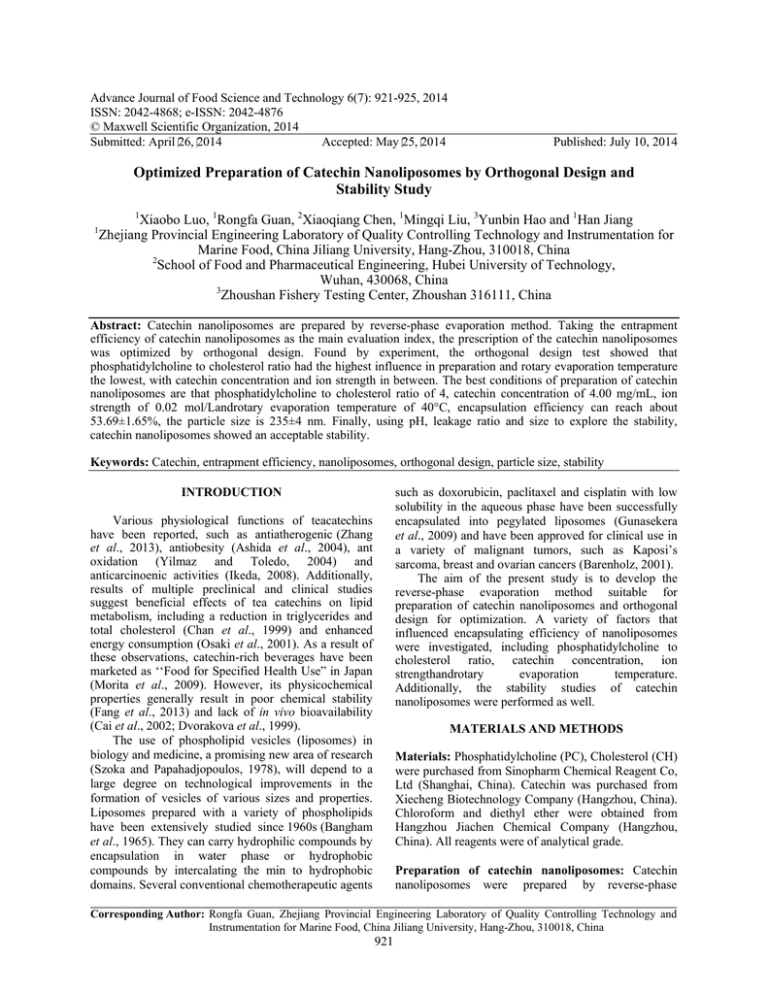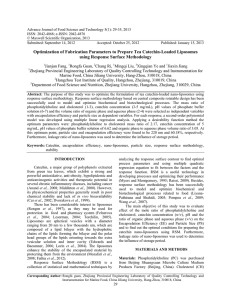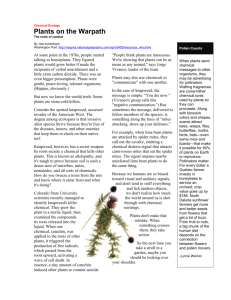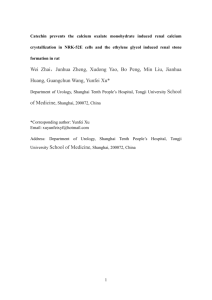Advance Journal of Food Science and Technology 6(7): 921-925, 2014
advertisement

Advance Journal of Food Science and Technology 6(7): 921-925, 2014 ISSN: 2042-4868; e-ISSN: 2042-4876 © Maxwell Scientific Organization, 2014 Submitted: April 26, 2014 Accepted: May 25, 2014 Published: July 10, 2014 Optimized Preparation of Catechin Nanoliposomes by Orthogonal Design and Stability Study 1 Xiaobo Luo, 1Rongfa Guan, 2Xiaoqiang Chen, 1Mingqi Liu, 3Yunbin Hao and 1Han Jiang Zhejiang Provincial Engineering Laboratory of Quality Controlling Technology and Instrumentation for Marine Food, China Jiliang University, Hang-Zhou, 310018, China 2 School of Food and Pharmaceutical Engineering, Hubei University of Technology, Wuhan, 430068, China 3 Zhoushan Fishery Testing Center, Zhoushan 316111, China 1 Abstract: Catechin nanoliposomes are prepared by reverse-phase evaporation method. Taking the entrapment efficiency of catechin nanoliposomes as the main evaluation index, the prescription of the catechin nanoliposomes was optimized by orthogonal design. Found by experiment, the orthogonal design test showed that phosphatidylcholine to cholesterol ratio had the highest influence in preparation and rotary evaporation temperature the lowest, with catechin concentration and ion strength in between. The best conditions of preparation of catechin nanoliposomes are that phosphatidylcholine to cholesterol ratio of 4, catechin concentration of 4.00 mg/mL, ion strength of 0.02 mol/Landrotary evaporation temperature of 40°C, encapsulation efficiency can reach about 53.69±1.65%, the particle size is 235±4 nm. Finally, using pH, leakage ratio and size to explore the stability, catechin nanoliposomes showed an acceptable stability. Keywords: Catechin, entrapment efficiency, nanoliposomes, orthogonal design, particle size, stability such as doxorubicin, paclitaxel and cisplatin with low solubility in the aqueous phase have been successfully encapsulated into pegylated liposomes (Gunasekera et al., 2009) and have been approved for clinical use in a variety of malignant tumors, such as Kaposi’s sarcoma, breast and ovarian cancers (Barenholz, 2001). The aim of the present study is to develop the reverse-phase evaporation method suitable for preparation of catechin nanoliposomes and orthogonal design for optimization. A variety of factors that influenced encapsulating efficiency of nanoliposomes were investigated, including phosphatidylcholine to cholesterol ratio, catechin concentration, ion strengthandrotary evaporation temperature. Additionally, the stability studies of catechin nanoliposomes were performed as well. INTRODUCTION Various physiological functions of teacatechins have been reported, such as antiatherogenic (Zhang et al., 2013), antiobesity (Ashida et al., 2004), ant oxidation (Yilmaz and Toledo, 2004) and anticarcinoenic activities (Ikeda, 2008). Additionally, results of multiple preclinical and clinical studies suggest beneficial effects of tea catechins on lipid metabolism, including a reduction in triglycerides and total cholesterol (Chan et al., 1999) and enhanced energy consumption (Osaki et al., 2001). As a result of these observations, catechin-rich beverages have been marketed as ‘‘Food for Specified Health Use” in Japan (Morita et al., 2009). However, its physicochemical properties generally result in poor chemical stability (Fang et al., 2013) and lack of in vivo bioavailability (Cai et al., 2002; Dvorakova et al., 1999). The use of phospholipid vesicles (liposomes) in biology and medicine, a promising new area of research (Szoka and Papahadjopoulos, 1978), will depend to a large degree on technological improvements in the formation of vesicles of various sizes and properties. Liposomes prepared with a variety of phospholipids have been extensively studied since 1960s (Bangham et al., 1965). They can carry hydrophilic compounds by encapsulation in water phase or hydrophobic compounds by intercalating the min to hydrophobic domains. Several conventional chemotherapeutic agents MATERIALS AND METHODS Materials: Phosphatidylcholine (PC), Cholesterol (CH) were purchased from Sinopharm Chemical Reagent Co, Ltd (Shanghai, China). Catechin was purchased from Xiecheng Biotechnology Company (Hangzhou, China). Chloroform and diethyl ether were obtained from Hangzhou Jiachen Chemical Company (Hangzhou, China). All reagents were of analytical grade. Preparation of catechin nanoliposomes: Catechin nanoliposomes were prepared by reverse-phase Corresponding Author: Rongfa Guan, Zhejiang Provincial Engineering Laboratory of Quality Controlling Technology and Instrumentation for Marine Food, China Jiliang University, Hang-Zhou, 310018, China 921 Adv. J. Food Sci. Technol., 6(7): 921-925, 2014 Table 1: Orthogonal design PC:CH Concentration of Level (w/w) catechin (mg/mL) A B 1 3:1 3 2 4:1 4 3 5:1 6 evaporation method (Lu et al., 2014). Briefly, a certain amount of PC and CH were dissolved in chloroformdiethyl ether and catechin was dissolved in phosphate buffer solution (pH7.4, PBS). The organic phase was mixed with the aqueous phase using probe sonication for 5 min. The mixture was placed in a round-bottom flask and a gel was formed by evaporating the organic solvent under reduced pressure using a rotary evaporator. Then 30 mL phosphate buffer solution containing surfactant was added and evaporated for another 20 min. LO = Qt − Q f Qt ∗ 100 (W EE − WEEt ) WEE × 100% (3) where, W EE = Encapsulation efficiency of preparation W EE t = Encapsulation efficiency of a certain period of time (Ma et al., 2012) (1) Encapsulation Efficiency (EE) determination: The encapsulation efficiency was determined by centrifugeUV method. Take lipsomes suspension (500 μL) by spinning at 10000 rpm for 30 min using centrifuge, the catechin content of the supernatant was measured by Bradford. The same suspension was ruptured using sufficient volume of ethanol and the total amount of catechin was determined spectrophotometrically. Encapsulation efficiency was calculated using Eq. (2): EE% = Temperature (°C) D 35 40 45 Storage stability: Catechin nanoliposomes were stored at 4°C in a refrigeratory. Take 0.50 mL samples at predetermine intervals. The leakage ratios of samples were calculated and pH was measured by pH meter. Leakage ratios were calculated using Eq. (3): Determination of catechin content: The content of catechin was analyzed by the chemical colorimetric technique. The maximum absorbance was at 260 nm, detectable by the UV/visible spectrophotometer. The linear equation of catechin standard curve was obtained: y = 3.6906x + 0.0358 (R 2 = 0.9959) Ion strength (mol/L) C 0.01 0.02 0.03 Effect of sonication: Ten milliliter catechin nanoliposomes were submitted to a probing sonication (VCX400, Sonics and Material, Inc., USA) process in an ice bath with a sequence of 1 sec of sonication and 1 sec rest (Guan et al., 2012). (0.2 mL) samples were taken at predetermine intervals. Encapsulation efficiency and particles size of with drawn samples were determined. The leakage ratios were calculated by Eq. (3). (2) Statistical analysis: The results were expressed as the mean±standard deviation. The statistical study was performed using SPSS, version 15.0 for windows. where, = The amount of free catechin Qf = The total amount of catechin present in 500 μL Qt of nanoliposomes (Ding et al., 2011) RESULTS AND DISCUSSION Surfactant screening: Surfactant molecules can be inserted into liposome phospholipid bilayer membrane and soften the bilayer membrane. Consequently, the lipid plasmid stability was enhanced. As shown in Table 2, tween 80 was selected as the surfactant for the following experiments (Fan et al., 2008). Particle size: The particle size was measured by Mastersizer (2000) instrument (Malvern), equipped with HydroMu dispersing unit (Malvern). Measurements were taken in the range between 0.1 and 1000 μm, under the following conditions: water refractive index 1.33 and general calculation model for irregular particles. The data obtained were averaged by software (Mastersizer, 2000; ver.5.20 from Malvern). Orthogonal design: In our study, the preparation formulation of catechin nanoliposome was optimized by the orthogonal experiment considering the effects of phosphatidylcholine to cholesterol ratio, catechin concentration, ion strength and rotary evaporation temperature in which the entrapment efficiency of nanoliposomes as the evaluation indice. The results were summarized in Table 3. The orthogonal design test showed that treatments of A 2 B 2 C 2 D 3 had the highest entrapment efficiency. Based on the R2, the importance of the independent variables on yield could be ranked in the following order: phosphatidylcholine Orthogonal design test: In order to screen optimum extraction conditions including the ratio of phosphatidylcholine to cholesterol (factor A), catechin concentration (factor B), ion strength (factor C), rotary evaporation temperature (factor D), orthogonal test with the four factors and three levels each factor (Table 1) was designed on software of the SAS System for Windows (version 8.01; SAS Institute Inc., Carry, NC, USA) (Dong et al., 2011). 922 Adv. J. Food Sci. Technol., 6(7): 921-925, 2014 Table 2: Screening of surfactants between tween 80, PVP, PEG2000, PEG4000 Surfactants Tween 80 PVP EE% 50.18±2.33 45.82±3.93 Table 3: Entrapment efficiency of the nanoliposomes prepared by reverse phase evaporation method in the orthogonal experiment Sample number A B C D EE (%) 1 1 1 1 1 36.04 2 1 2 2 2 55.19 3 1 3 3 3 46.17 4 2 1 2 3 53.38 5 2 2 3 1 52.66 6 2 3 1 2 48.11 7 3 1 3 2 39.72 8 3 2 1 3 44.15 9 3 3 2 1 42.49 K1 45.80 43.04 42.77 43.73 K2 51.38 50.60 50.26 47.90 K3 42.12 45.59 45.85 49.90 R2 9.26 7.56 7.49 6.17 Optimization: The optimum formulation conditions were as follows: phosphatidylcholine to cholesterol ratio of 4, catechin concentration of 4.00 mg/mL, ion strength of 0.02 mol/L and rotary evaporation temperature of 40°C. The conditions given the highest encapsulation efficiency (53.69±1.65%) with the low value of the particle size (235±4 nm) (Table 4). Catechin nanoliposomes of optimized formulation were used for determination of particle size distribution (Fig. 1). Intensity (percent) Storage stability: The catechin nanoliposomes were subjected to storage stability study for the period of 30 days in 4°C. The storage stability of catechin nanoliposomes composed of phosphatidylcholine to cholesterol ratio of 4, catechin concentration of 4.00 mg/mL, ion strength of 0.02 mol/Land rotary evaporation temperature of 40°C, is presented in Fig. 2. As it shows, pH and the leakage ratio of catechin nanoliposomes tended to increase with increasing storage period. The leakage of catechin nanoliposomes might be attributed to hydroxylation and degradation of bilayer membranes and/or vesicle fusion/aggregation (Flaten et al., 2008; Hincha, 2003). Size distribution by intensity 8 6 4 2 0 0.1 1 10 100 Size (d.nm) 1000 PEG4000 49.02±2.79 Additionally, the various ion strengths of phosphate buffer markedly change the encapsulating efficiency. The large effect in the encapsulating efficiency probably attributed to the competition of water between electrolyte and lipid for hydration. Table 4: Experimental values of the evaluation indices obtained at optimum conditions Evaluation indices Experimental value EE (%) 53.69±1.65 Size (nm) 235±4 10 PEG2000 46.71±1.24 10000 Effect of sonication: Sonication was used to form a w/o emulsion with thereverse-phase evaporation method and to control and reduce the size of micro vesicles (Yamaguchi et al., 2009). The stability of catech in nanoliposomes was evaluated by measuring the change of particle size and leakage ratio was shown in Fig. 3. After 20 min sonication on nanoliposomes, the leakage ratio was 14.89% which was higher than the release ratio of 15 min sonication. This may be caused by the extension of ultrasonic total time, the crushed particles had been gained new energy, resulting in achange of stability. With time increased, the size of nanoliposomes became smaller. This is due to ultrasound phenomena in liquid media enhance mass transports of their constituents in a non-homogeneous fashion allowing the fast formation of vesicles (Basto et al., 2007). After 15 min sonication on catechin nanoliposomes, the particle size did not change so much. Above all, the 15 min sonication time on catechin nanoliposomes may be fit for preparing. Fig. 1: The particle size of optimized catechin nanoliposomes to cholesterol ratio>catechin concentration>ion strength>rotary evaporation temperature. The effect of the phosphatidylcholine to cholesterol ratio on the entrapment efficiency was most significant due to that phospholipids are major components of liposomes and have a greater impact on the quality of liposomes. The increase of phospholipid concentration in the aqueous phase will enhance the viscosity of the suspension, as well as the particle size, resulting in reduced liposome stability. However, the decrease of phospholipids concentration will result in too low system drug concentration, thus affecting the whole system and the drug loading (Song et al., 2011). Cholesterol had been shown to modify the order and mobility of the phosphatidylcholines in the bilayer and the content of cholesterol might be of crucial importance for the effective delivery of liposomeentrapped substances into the skin (Ma et al., 2009). 923 Adv. J. Food Sci. Technol., 6(7): 921-925, 2014 Fig. 2: Storage stability of catechin nanoliposomes Data reported are the mean values±standard variation of three replications Fig. 3: The effect of sonication on catechin nanoliposomes Data reported are the mean values±standard variation of three replications CONCLUSION vivo and in nanoliposomes. Catechinnanoliposome was prepared by reversephase evaporation method based on the results of the orthogonal experiment. Phosphatidylcholine to cholesterol ratio and catechin concentration are the major factors to influence the encapsulation efficiency of catechin nanoliposomes. Numerical optimization determined the optimum preparation conditions, which were phosphatidylcholine to cholesterol ratio of 4, catechin concentration of 4.00 mg/mL, ion strength of 0.02 mol/Landrotary evaporation temperature of 40°C. The entrapment efficiency of catechin was 53.69±1.65% and the particle size was 235±4 nm. Finally, catechin nanoliposomes showed an acceptable stability in which the pH, leakage ratio and size of catechin nanoliposomes were measured as the evaluation indices. Further study is needed to verify in food bioavailability of catechin ACKNOWLEDGMENT This study was supported by Zhejiang Provincial Engineering Laboratory of Quality Controlling Technology and Instrumentation for Marine Food. We gratefully acknowledge financial support from Zhejiang Provincial Natural Science Foundation of China (LY14C200012) and Zhejiang Provincial Public Technology Application Research Project (2012C22052) and General Administration of Quality Supervision, Inspection and Quarantine of the People’s Republic of China (201310120) and Hangzhou Science and Technology Development Project (20130432B66, 20120232B72). 924 Adv. J. Food Sci. Technol., 6(7): 921-925, 2014 Gunasekera, U.A., Q.A. Pankhurst and M. Douek, 2009. Imaging applications of nanotechnology in cancer. Target. Oncol., 4: 169-181. Hincha, D.K., 2003. Effects of calcium-induced aggregation on the physical stability of liposomes containing plant glycolipids. BBA-Biomembranes, 1611: 180-186. Ikeda, I., 2008. Multifunctional effects of green tea catechins on prevention of the metabolic syndrome. Asia Pac. J. Clin. Nutr., 17: 273-274. Lu, Q., P.M. Lu, J.H. Piao, X.L. Xu, J. Chen, L. Zhu and J.G. Jiang, 2014. Preparation and physicochemical characteristics of an allicin nanoliposome and its release behavior. LWT-Food Sci. Technol., 57: 686-695. Ma, Q.H., Y.Z. Kuang, X.Z. Hao and N. Gu, 2009. Preparation and characterization of tea polyphenols and vitamin E loaded nanoscale complex liposome. J. Nanosci. Nanotechno., 9: 1379-1383. Ma, J.Q., R.F. Guan, C. Ri, M.Q. Liu, X.Q. Ye and J.X. Jiang, 2012. Response surface methodology for the optimization of lactoferrin nano-liposomes. Adv. J. Food Sci. Technol., 4: 249-256. Mastersizer, 2000. User manual. Malvern Instruments Ltd. 2007. Morita, O., J.B. Kirkpatrick, Y. Tamaki, C.P. Chengelis, M.J. Beck and R.H. Bruner, 2009. Safety assessment of heat-sterilized green tea catechin preparation: A 6-month repeat-dose study in rats. Food Chem. Toxicol., 47: 1760-1770. Osaki, N., U. Harada, H. Watanabe, K. Onizawa, T. Yamaguchi, I. Tokimitsu, H. Shimasaki and H. Itakura, 2001. Effect of tea catechins on energy metabolism in rats. J. Oleo Sci., 50: 677-682. Song, J., F. Shi, Z.H. Zhang, F.X. Zhu, J. Xue, X.B. Tan, L.Y. Zhang and X.B. Jia, 2011. Formulation and evaluation of celastrol-loaded liposomes. Molecules, 16: 7880-7892. Szoka, F. and D. Papahadjopoulos, 1978. Procedure for preparation of liposomes with large internal aqueous space and high capture by reverse-phase evaporation. Proc. Natl. Acad. Sci. USA, 75: 4194-4198. Yamaguchi, T., M. Nomura, T. Matsuoka and S. Koda, 2009. Effects of frequency and power of ultrasound on the size reduction of liposome. Chem. Phys. Lipids, 160: 58-62. Yilmaz, Y. and R.T. Toledo, 2004. Major flavonoids in grape seeds and skins: Antioxidant capacity of catechin, epicatechin and gallic acid. J. Agr. Food Chem., 52: 255-260. Zhang, J., S.F. Nie and S. Wang, 2013. Nanoencapsulation enhances epigallocatechin-3gallate stability and its antiatherogenic bioactivities in macrophages. J. Agr. Food Chem., 61: 9200-9209. REFERENCES Ashida, H., T. Furuyashiki, H. Nagayasu, H. Bessho, H. Sakakibara, T. Hashimoto and K. Kanazawa, 2004. Anti-obesity actions of green tea: Possible involvements in modulation of the glucose uptake system and suppression of the adipogenesis-related transcription factors. Biofactors, 22: 135-140. Bangham, A.D., M.M. Standish and J.C. Watkins, 1965. Diffusion of univalent ions across the lamellae of swollen phospholipids. J. Mol. Biol., 13: 238-252. Barenholz, Y., 2001. Liposome application: Problems and prospects. Curr. Opin. Colloid In., 6: 66-77. Basto, C., T. Tzanov and A. Cavaco-Paulo, 2007. Combined ultrasound-laccase assisted bleaching of cotton. Ultrason. Sonochem., 14: 350-354. Cai, Y., N.D. Anavy and H.S. Chow, 2002. Contribution of presystemic hepatic extraction to the low oral bioavailability of green tea catechins in rats. Drug Metab. Dispos., 30: 1246-1249. Chan, P.T., W.P. Fong, Y.L. Cheung, Y. Huang, W.K.K. Ho and Z.Y. Chen, 1999. Jasmine green tea epicatechins are hypolipidemic in hamsters (Mesocricetus auratus) fed a high fat diet. J. Nutr., 129: 1094-1101. Ding, B.M., X.M. Zhang, K. Hayat, S.Q. Xia, C.S. Jia, M.Y. Xie and C.M. Liu, 2011. Preparation, characterization and the stability of ferrous glycinate nanoliposomes. J. Food Eng., 102: 202-208. Dong, J.J., J.H. Ye, J.L. Lu, X.Q. Zheng and Y.R. Liang, 2011. Isolation of antioxidant catechins from green tea and its decaffeination. Food Bioprod. Process., 89: 62-66. Dvorakova, K., R.T. Dorr, S. Valcic, B. Timmermann and D.S. Alberts, 1999. Pharmacokinetics of the green tea derivative, EGCG, by the topical route of administration in mouse and human skin. Cancer Chemoth. Pharm., 43: 331-335. Fan, M.H., S.Y. Xu, S.Q. Xia and X.M. Zhang, 2008. Preparation of salidroside nano-liposomes by ethanol injection method and in vitro release study. Eur. Food Res. Technol., 227: 167-174. Fang, J.J., R.F. Guan, C. Ri, M.Q. Liu, X.Q. Ye and J.X. Jiang, 2013. Optimization of fabrication parameters to prepare tea catechin-loaded liposomes using response surface methodology. Adv. J. Food Sci. Technol., 5: 29-35. Flaten, G.E., K. Luthman, T. Vasskog and M. Brandl, 2008. Drug permeability across a phospholipid vesicle-based barrier: 4. The effect of tensides, cosolvents and pH changes on barrier integrity and on drug permeability. Eur. J. Pharm. Sci., 34: 173-180. Guan, R.F., J.Q. Ma, Y.H. Wu, F. Lu, C.G. Xiao, H. Jiang and T.S. Kang, 2012. Development and characterization of lactoferrin nanoliposome: Cellular uptake and stability. Nanoscale Res. Lett., 7: 1-6. 925



